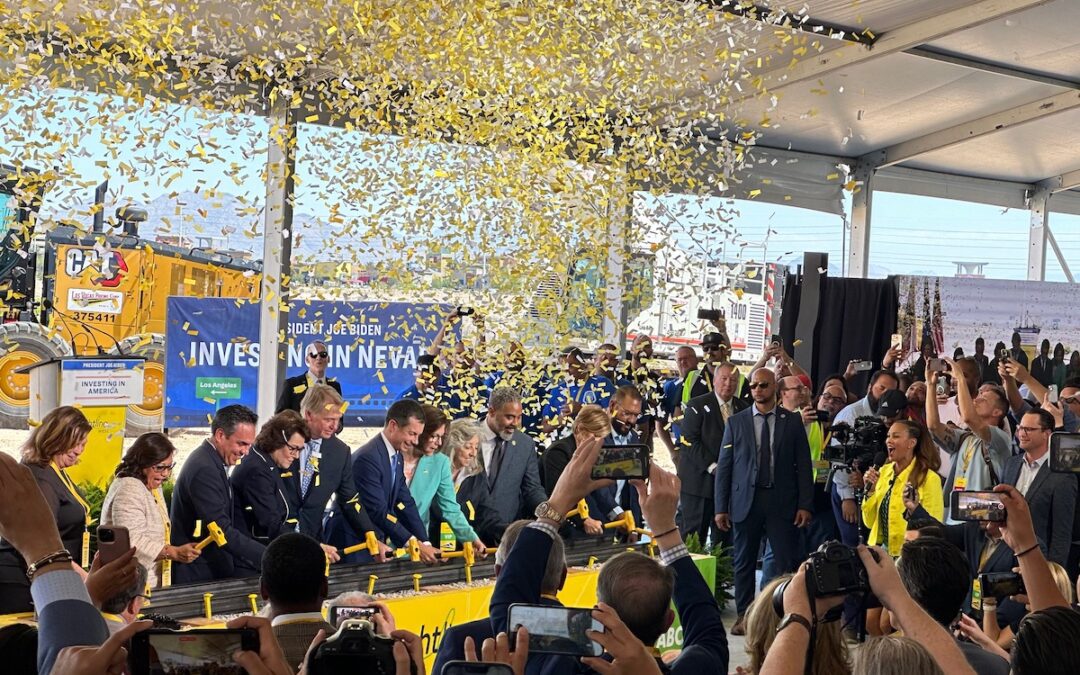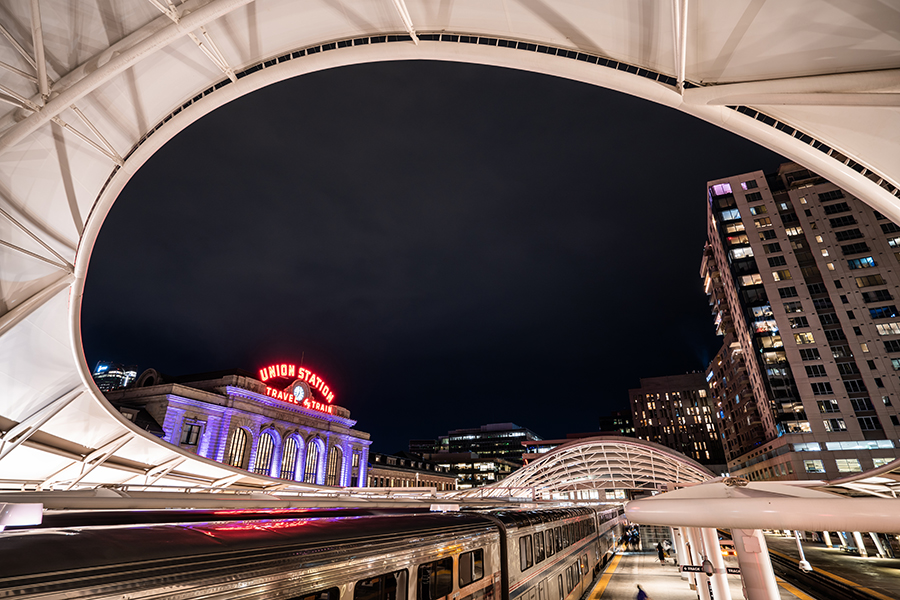The railroad Brightline today broke ground in Nevada on its new Brightline West project. Brightline will use trains traveling up to 200 miles per hour to cut the travel time between Las Vegas and Los Angeles in half. The company already operates successful trains...
Guest Blog by Dan Bilka
Image: Proposed Routes for Sec. 22214 Studies, primary routing options highlighted in yellow. Base map: Rail Passengers Association “Grid and Gateway” Vision Map.
Over a half century ago, the United States created Amtrak to rescue the vestiges of a once thriving national passenger rail system operated by private railroads. Posting record ridership prior to the pandemic, Amtrak has become an integral part of over 500 communities nationwide.
Yet we can do much better. The creation of Amtrak itself resulted in large swaths of the country being left without passenger rail service literally overnight. Since then, while Amtrak has opened a handful of new routes and boosted frequencies on others, it has also abandoned thousands of miles of long-distance trains, leaving major cities and rural communities alike far from service.
Last year’s passage of the Bi-partisan Infrastructure Investment and Jobs Act (IIJA) is a once-in-generations opportunity to go beyond the status quo of previous decades. We have the opportunity, and I say obligation, to start constructing a National Network in the true sense of the word. A National Network means one that provides passenger rail service to all parts of the country, not one that leaves entire swaths isolated without service. In recognition of the call to action made by Rail Passengers Association President Jim Mathews, I want to do what I can to ensure these funds are spent “are spent wisely and well.”
My primary purpose for this writing is careful consideration for routes to be selected under Sec. 22214 (the Tester Amendment), the “Amtrak Daily Long-Distance Service Study” in order to garner the most “bang for our buck” for enhancement and growth of our National Network, the backbone for all other routes and services. Long-distance routes are not “Legacy” routes as described by some, they are “Multipurpose mobility machines“; lifelines for rural America. They are the proper scale and type of service to initiate passenger rail where we have no such services today. The primary market for long-distance national network services is not the endpoint-to-endpoint (i.e., Chicago to Los Angeles) but service to the hundreds of communities in between major hubs.
I thank Senator Jon Tester along with Sens. Wicker and Manchin for getting this language into the Bill and ensuring it wasn’t negatively altered along the way. We as a nation must make a commitment to all our citizens, including those in so-called “flyover country”.
National Planning Perspective
Today’s passenger rail system is not nearly as robust as it should be. How the system was rationalized and reduced by the constituent railroads running their own services (looking mainly at their own route networks, not the network at large), and the system as it was conveyed to Amtrak in 1971, has largely dictated the skeletal network we have today. The ill-conceived 1979 and 1997 cuts exacerbated this problem.
No train in the continental United States should ever run less-than-daily-service. Indeed, if you’re already going through the work to study a line, you should also consider what multiple frequencies per day would offer. The old [pre-Amtrak] railroad adage was: “If you double frequency, you triple ridership”; I believe that phenomena still holds true today (NUMTOTS, please chime in here). Further, because transportation systems have high fixed costs like infrastructure and station maintenance, Amtrak could double service without doubling operating costs.
Therefore, the USDOT/FRA should evaluate all routes selected under Sec. 22214 for multiple frequencies per day. This does not mean that service must immediately jump to multiple frequencies, but planners and policymakers should have an honest and thorough understanding how multiple frequencies per day enhance ridership, financial performance, and usability/attraction; plan and actually implement the increased frequencies at a later date.
Cobbling together short-distance passenger rail segments does not form a complete transportation network. The “long-distance” routes build the foundation for “state-supported” services; we need to have them in order to construct our 21st century transportation network. “Long-distance routes are themselves a series of corridors; lifelines for the communities and people they serve. We must move beyond a “zero-sum” mindset; long-distance routes are not a threat to state-supported routes but a benefit to them. State supported routes can complement and enhance long-distance service but they cannot replace it. If it were not for the coordination and investment of the federal government, we would not have the US Interstate Highway System or world-class aviation network. If it were up to states themselves to construct the US Interstate Highway System, analogous to what is being proposed for state-supported routes on the Amtrak “Connects US” map, we wouldn’t have anything resembling the US Interstate Highway System today. If it were not for the coordination of the FAA and Air Traffic Control, airliners may still be crashing into one another.
While some are promoting the “Connects US” map and self-defeating sole focus on a “state-supported” model, one that leaves gaps that make it impossible to travel between some adjacent metropolitan areas, the US Congress has spoken loud and clear: enshrining National Network commitment into law. There are much-needed Amtrak reforms, now explicitly outlining a commitment to the National Network and rural America (Sec. 22201), Amtrak Board Reforms (Sec. 22202), Oversight on Amtrak for Long-distance and other services (Sec. 22204), and better oversight of Amtrak Spending (Sec. 22206). This was the result of hard-working advocates calling for specific safeguards and explicit federal commitment to these fundamental long-distance routes.
Cost Comparisons: “Long-distance” Routes: Multipurpose Mobility Machines
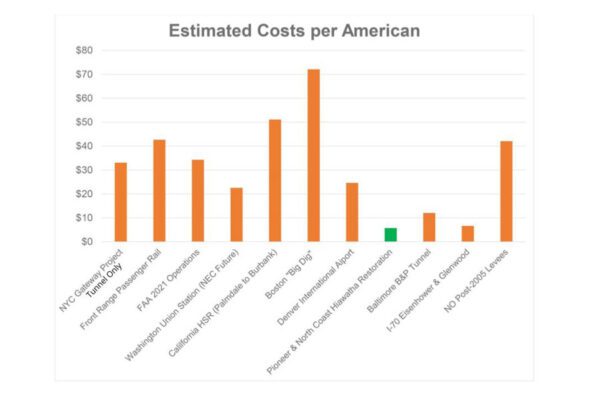
Cost comparisons of critical projects, historical and present, in estimated costs per American in 2021 dollars.
Implementing “long-distance” services is actually relatively inexpensive, especially compared to the (yes,needed and valuable) services for urban metro areas and the coasts, most vividly the Northeast Corridor (NEC). If the NEC were profitable, it would not require any public investment or funding (federal, state, or local) whatsoever. Depreciation (wear and tear on long-lived assets) on the NEC is not factored in as an operational cost as GAAP (Generally Accepted Accounting Principles) require. Ignored is the cost of capital consumption. By definition, if any part of an operation requires public funds, it is not profitable. All transportation projects require public investment to realize the even greater benefits to the public.
As I explained in my Railway Age opinion piece in August 2021, I do support these critical projects (such as the Gateway Tunnel). However, they cannot become the be-all, end-all of rail and transportation investment. For the Gateway Tunnel (quoted recently as $12 Billion), we could implement 12 long-distance routes assuming $1B/route track upgrades, stations and rolling stock as a rough order of magnitude cost estimate. At $6.4 billion, the second phase of the long-needed New York City 2nd Avenue Subway costs roughly the same as initiating rail service on six long-distance routes over multiple states, not just multiple city blocks.
This will entail close collaboration with host (freight) railroads. We understand they have a business to run and we are not here to impede their freight operations nor do we expect them to “subsidize” passenger rail operations. However, host railroads have also been the beneficiaries of public investment, from 19th century land grants to today’s grade separations. We can find win-win opportunities to leverage existing infrastructure in a more fiscally-responsible manner than requiring expensive, separate rights of way where travel demand does not warrant them. Let’s lay the groundwork today to demonstrate why we need that for our futures. The Steel Interstate proposal takes recognition of this concept. Together, the challenges and opportunities of passenger and freight rail compound to call for a reinvestment of our national rail system. Mixed-use lines, mixed-use opportunities, mixed-use funding.
Our national rail system is inadequate for the needs of the 21st century; it is upon us to address this if we wish to remain competitive in the world today. Indeed, former Amtrak President David Gunn was right when he noted “Amtrak is the canary in the coal mine” when it came to constraints on our national rail system. Long disadvantaged by massive federal and state subsidies to their highway and aviation counterparts, it is time for an equitable investment in rail infrastructure.
Criteria & Evaluation Process
Serving on the Rail Passengers Association Routes and Schedules Committee since 2016, I have evaluated and developed a list that fulfills the criteria and intention of Sec. 22214. These are the routes that have the best “bang for our buck”, nationally; exploring the opportunity for service and equity to the entirety of the Continental 48. I took inspiration from numerous other groups such as the America2050 proposal, High Speed Rail Alliance, Rail Passengers, Alfred Twu’s now tweet-viral vision, the FRA Region Rail Plans, and even the Amtrak “Connects US” map (while noting omissions and missed opportunities like Louisville to Nashville) to vet out proposed routings. I’ve also been reviewing our Rail Passengers Association (then called the National Association of Railroad Passengers, NARP) 1978 and 2006 Routes & Schedules Reports for Amtrak Expansion and found considerable overlap with routes proposed by other plans and my list here. More studies and expansions should be done; however, the current funds are limited.
Side note: it’s important to recognize and support Alaska, Hawaii, and US territories transportation capabilities and infrastructure too; I haven’t forgotten about you!
Key considerations: “(1) any [not all] Amtrak long-distance routes that, as of the date of enactment of this Act, were discontinued; and (2) any [should be read as ‘all’] Amtrak long-distance routes that, as of the date of enactment of this Act, occur on a nondaily basis…specific [not sole] attention paid to routes in service as of April 1971…Link and serve large and small communities as part of a regional rail network; advance economic and social well-being… provide enhanced connectivity for the national long-distance passenger rail system, and reflect public engagement and local support.”
I have extensively studied the routes in operation in April of 1971 and have garnered new insights as to the state of the national system at that point. Many of the routes operating just prior to Amtrak don’t meet “Long-distance” criteria (a number due to service reductions prior) or are routes that closely reflect other routes (i.e. City of Portland/Portland Rose and the Pioneer). There are a few worthy routes from April 1971, however the slate here proposed helps provide geographic coverage in their general areas and east-west/north-south capabilities in some capacity while connecting vibrant local and regional economic & political hubs of “Flyover” America.
This list is not to be the definitive limit for all studies that can/should be done. For example, studies that look at a new section or split of existing services (i.e. a Detroit/D.C. leg on the National Limited) should be done under the Corridor Development Program since all “Long-distance” trains are a series of corridors (but not all corridors are “long-distance” trains) such as a Crescent extension to Dallas/Ft. Worth, even while continued operation costs would come through long-distance federal budget appropriations. A number of discontinued Amtrak long-distance routes have close active reflections today (Champion and Florida Special with the Silver Services; Hilltopper, Mountaineer, and James Whitcomb Riley for the Cardinal; etc.).
This should not be a one-off study exercise, a thought experiment, but the first step into realizing a truly national (and continental) passenger rail network. Once these routes are thoroughly evaluated, funded, and implemented; we should indeed go back and improve and increase other nationally-essential long-distance routes (Southwest Chief, City of New Orleans, The Crescent, etc.) while concurrently enhancing and growing local and regional services. The Lakeshore Rail Alliance is on the right path, looking to evaluate the Lakeshore Limited route for 4-times-per-day, minimum.
These are the routes that would best build up National Network equity, focusing on geographic equity & currently un-served areas, serving disadvantaged populations, and filling in the greatest voids on our existing National Network.
Tester Amendment Studies Proposed (Sec. 22214)
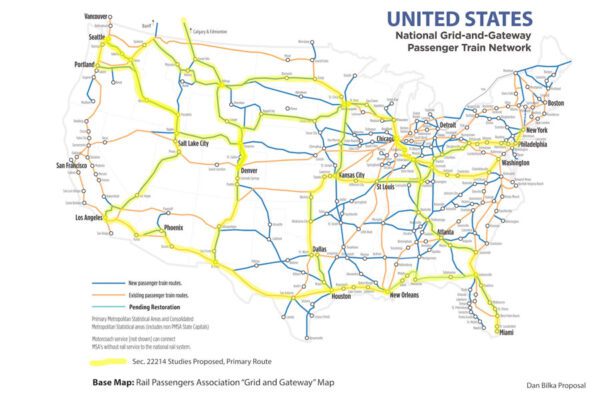 1. Daily “Cardinal”
1. Daily “Cardinal”
2. Daily “Sunset Limited” through downtown Phoenix (all the way to Florida if the recent 2017 Gulf Coast Working Group reports don’t have a shelf life)
3. ”The Pioneer” Denver – Cheyenne – Rock Springs – Ogden [Salt Lake City Connection] – Pocatello – Boise – Portland – Seattle.
4. ”North Coast Hiawatha” (Via Southern North Dakota and Southern Montana).
5. ”The Floridian” (Via Louisville, Nashville, Atlanta, Savannah)
6. ”Desert Wind Stampede” Las Angelos – Las Vegas – Salt Lake City – Pocatello – Boise – Pendleton – Pasco – Yakima – Seattle (Stand-alone from the Pioneer & Zephyr: via Southern Idaho and Stampede Pass Washington. Note shifting travel patterns in the Greater West – migration pipeline from Southern California to Boise & the Treasure Valley).
7. Calgary, AB – Denver – El Paso
8. *Minneapolis/St. Paul – Sioux Falls – Rapid City – Cheyenne – Denver
9. “Twin Star Rocket” (Minneapolis/St. Paul- Des Moines – Kansas City – Wichita – Oklahoma City – Dallas/Ft. Worth/Houston/Laredo), (Already service from Oklahoma City to Dallas/Ft. Worth).
10. “National Limited” New York City – Pittsburg – Columbus – Cincinnati – Louisville – St. Louis – Kansas City (Already service from Pittsburgh to NYC, Pittsburgh to Chicago, Pittsburgh to Washington D.C. & St. Louis to Kansas City).
These routes above fulfill:
1. Ensure that no route runs less than daily service (Again, studies should be run for multiple-daily frequencies as characteristics of the route demand.)
2. Promote geographic equity; promoting service to those places without service today; serve the continental 48.
3. Building up a backbone of long-distance routes that can facilitate travel north-south, east-west.
4. Build multimodal connection points with other routes and services including “state-supported” service.
*South Dakota has been left off the National Network since before the inception of Amtrak. Not for the lack of need or viability but due to the forces that predated the concept of Amtrak. It is now time to change that.
Greater Northwest Passenger Rail Working Group
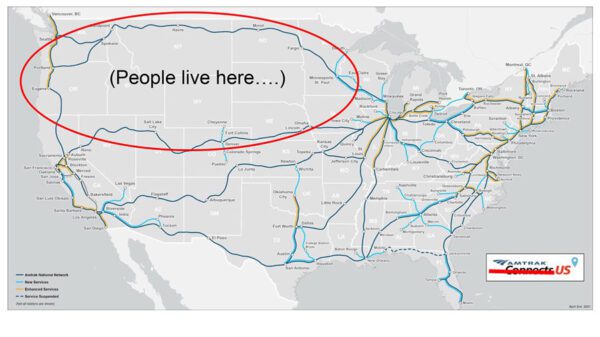 I specifically call on some of the routes in question, focused on the Northwest Region of the United States, to be evaluated through a Working Group; understanding the region in an integrated network approach. It should be noted that there is powerful bi-partisan US Senatorial support for the full Greater Northwest Passenger Rail Working Group and support from communities across the region; even by those who have never [yet] had Amtrak service. Again, the language of Sec. 22214 gives specific latitude to the Secretary of Transportation to create working groups to facilitate these studies.
I specifically call on some of the routes in question, focused on the Northwest Region of the United States, to be evaluated through a Working Group; understanding the region in an integrated network approach. It should be noted that there is powerful bi-partisan US Senatorial support for the full Greater Northwest Passenger Rail Working Group and support from communities across the region; even by those who have never [yet] had Amtrak service. Again, the language of Sec. 22214 gives specific latitude to the Secretary of Transportation to create working groups to facilitate these studies.
This working group, modeled on the successful Gulf Coast Working Group, is the correct forum, scale, and type of service (so-called “long-distance”) to evaluate the challenges and opportunities for passenger rail in our region.
Side Note: It is imperative that we also give voice and call for the restoration of Gulf Coast service, not only to Mobile, but all the way to Florida as outlined in the recommendations of the Gulf Coast Working Group. I hope that the STB will be able to find a workable solution for all parties.
Alternatively, I would like to enquire with the USDOT/FRA if there is also the possibility to establish this Working Group under the regional and National Rail Planning PRIIA has already directed them to do (Note: much of the Greater Northwest is still a void), as long as this method would not lock the group into a “State-supported” model. Such a model is inappropriate and self-defeating for building the true National Network we need and deserve. Ultimately, I’d like to ask what funding is available today to the USDOT/FRA in order to start evaluating these routes. I hope you can rustle up funding so we can get going. Our Coalition is ready to do the hard work that needs to be done, if we’re empowered to act.
Next Steps
I want to do what I can to jump start the conversation for the USDOT/FRA to be efficient and effective with the limited time and resources afforded to them. It’s time to build a truly robust national network, that is National and a Network.
If you are wondering what you (the reader) can do to help, please consider writing to your members of Congress, state houses, local governments, and local movers & shakers. Funding and implementation are a later conversation but simply being honestly-considered for passenger rail service is the first step we need to make. The time is upon us and the opportunity is now to make sizable and meaningful improvements to our national passenger rail network.
Contact your representatives in DC here.
Contact your state capital here.
Also please consider donating to state or national passenger rail/transportation advocacy organizations like the High Speed Rail Alliance, Rail Passengers Association, or Transportation for America. We would not have the opportunity before us if it was not for the hard work of their small (but mighty) staff and advocates across the nation!
About Dan
Dan Bilka is an architectural designer by training, a Board Member of the Rail Passengers Association (former South Dakota Representative), Board member of the Colorado Rail Passengers Association, Coordinator with the Greater Northwest Passenger Rail Coalition, and Co-Founder & President of All Aboard Northwest. The opinions expressed here are his own and do not reflect the views of the organizations he is a member of.
The Latest from HSRA
Our Latest Blog Posts
Check out the latest news, updates, and high speed rail insights from our blog!
